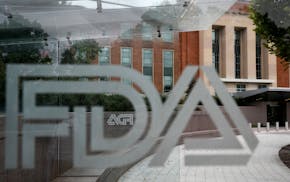Minnesota will have the nation's best-funded tractor safety plan now that Gov. Mark Dayton has signed off on legislation that creates the state's first program to help farmers add rollover protection to aging machines.
But that is just a first step toward reducing farm accidents in Minnesota. In response to a Star Tribune series on farm safety, state lawmakers also approved legislation that requires the Minnesota Department of Agriculture to study farm safety programs in other states and report back by Feb. 1, 2017 on ideas that could be implemented here.
"There has been a renewed focus on farm safety, and there should be," said Rep. Paul Anderson, a Republican farmer from Starbuck who led the effort to reduce tractor rollovers in Minnesota. "Next year is a budget year, and I would certainly be in favor of looking at some additional funding for farm safety."
Anderson and other legislators said they were prompted to act by a Star Tribune series that revealed how fatal farm accidents jumped by more than 30 percent in Minnesota over the past decade, an increase mirrored in several other Midwestern states.
Tractor accidents were the No. 1 cause of death, accounting for more than 1,700 fatalities among U.S. farmworkers since 2003. In Minnesota, where 210 farmworkers were killed in the past decade, the majority of fatal tractor accidents occurred on older machines that lacked rollover protection, records show.
The best way to avoid catastrophe is to install a roll bar, but most farmers have resisted calls to add the equipment, often citing the cost of the upgrade. It typically costs about $900 to add the gear, but some kits are more than twice as expensive.
Under Minnesota's program, which will launch later this month, farmers would be reimbursed for 70 percent of the cost of adding rollover protection, with that figure increasing as needed to cap a farmer's out-of-pocket costs at $500 per tractor. Any tractor built before 1987 — or shortly after manufacturers began voluntary including rollover protection — qualifies for help.
The program will be run by the state Agriculture Department, which will receive $250,000 in annual funding, equal to the support received by a similar program in New York. But Anderson also has raised $27,500 in funds from the private sector, giving Minnesota's program the most financial support of the seven states now offering such assistance. Among those contributing to Minnesota's tractor campaign: ADM, Cargill, CHS Stewardship and Land O'Lakes Inc.
Still, $277,500 won't come close to covering the need. State officials estimate that there are more than 80,000 vintage tractors that lack roll bars or covered cabs in Minnesota, which means it would take about 300 years at current funding levels to upgrade all those tractors.
When used with a seat belt, roll bars are 99 percent effective in preventing death or serious injury in a tractor overturn, according to the National Institute for Occupational Safety and Health.
Advocates have struggled for more than a decade to find money to create a national tractor safety program. Currently, just a handful of states are trying to start programs, and none of them have found public support, according to Julie Sorensen, director of the New York Center for Agricultural Medicine and Health, which is coordinating the effort.
Minnesota will be piggybacking on New York's long-standing program, using its call center, marketing and website services. The free partnership will save Minnesota thousands of dollars in administrative expenses, allowing the vast majority of the money to go toward rollover protection, Sorensen said.
About 20 percent of Minnesota's money has been reserved for promotion, a key part of the success of New York's tractor program. "One of the things we've found is that farmers can't take advantage of a program they don't know anything about," Sorensen said.
State lawmakers said they've heard from farmers and tractor dealers around the state who are looking forward to participating in the program. They've also heard from farmers who are concerned that they will be forced to add roll bars to their vintage vehicles. Anderson stressed that the program is completely voluntary.
Looking ahead, Anderson hopes to find additional funds to expand safety training in Minnesota, an area that has been hurt by millions of dollars of budget cuts. Anderson said he would like to offer farmers free classes that would enable them to learn how to safely operate skid-steer loaders and other machines that have proved popular but sometimes deadly for farmers.
In Wisconsin, where officials became concerned after several fatalities involving skid-steer machines killed workers on dairy farms, more than 500 farmworkers have been trained on skid-steer operations in recent years.
Lawmakers also cited a need to focus safety efforts on immigrants, particularly Spanish-speaking workers who now make up a substantial portion of the workforce on Minnesota dairy farms.
Rep. Clark Johnson, a Democrat from North Mankato, said he would like to see the state expand its ability to offer free safety audits to farmers, similar to the way such services are offered in Washington state. Washington officials say their state's extraordinarily low farm fatality rate is directly linked to the popularity of its consulting unit, which visited more than 294 agricultural operations last year.
By contrast, just 10 farms have received free safety audits in Minnesota since 2010, largely because the service is limited to operations with more than 10 workers. Such audits allow farmers to identify dangerous work conditions or practices without the fear of state penalties.
"We have lagged on worker safety," Johnson said. "I think there is a strong appetite for some common-sense legislation that would help farmers make their operations safer."
Jeffrey Meitrodt • 612-673-4132

Senate passes bill forcing TikTok's parent company to sell or face ban, sends to Biden for signature
USPS commits to rerouting Reno-area mail despite bipartisan pushback and mail ballot concerns

